2003 CHRYSLER CARAVAN fuel tank removal
[x] Cancel search: fuel tank removalPage 2104 of 2177
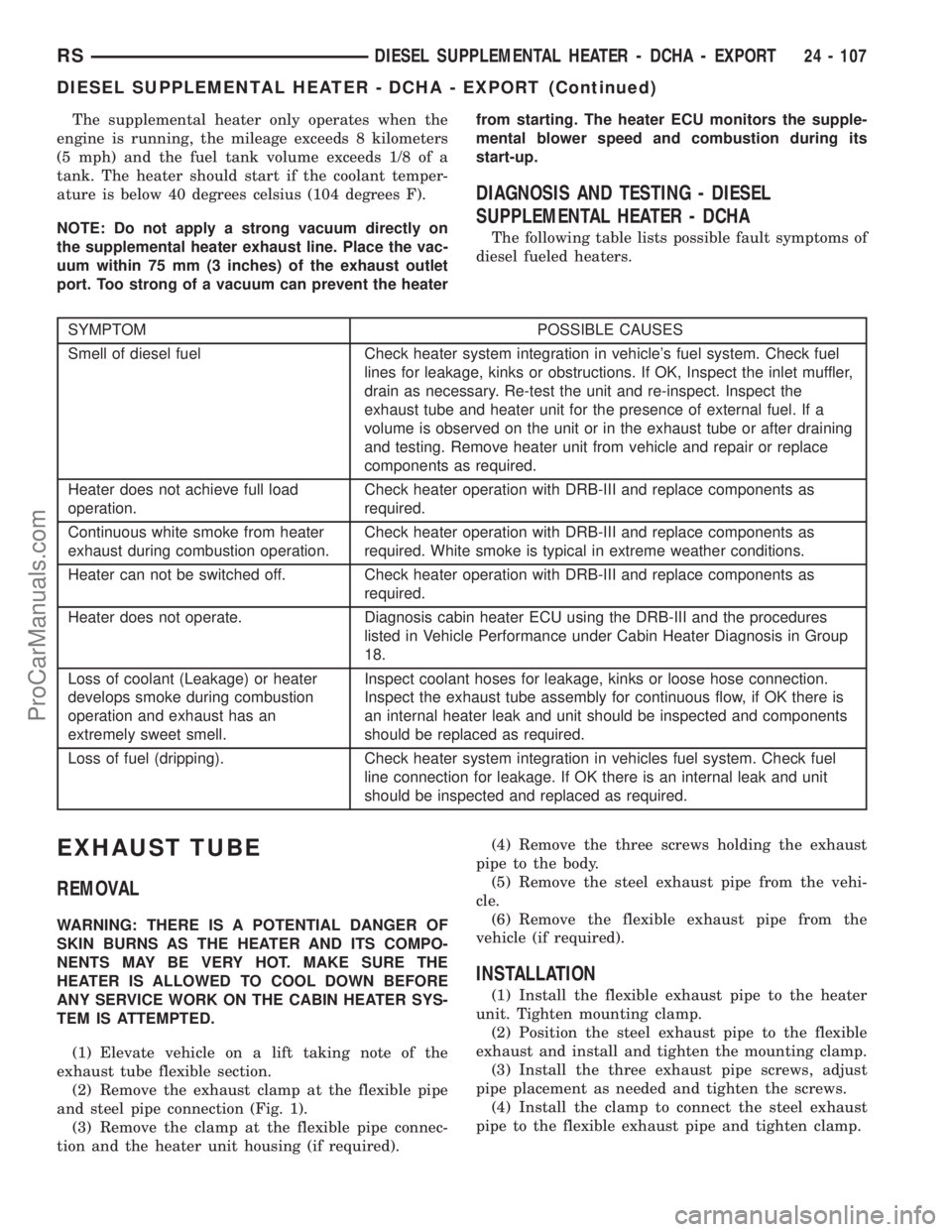
The supplemental heater only operates when the
engine is running, the mileage exceeds 8 kilometers
(5 mph) and the fuel tank volume exceeds 1/8 of a
tank. The heater should start if the coolant temper-
ature is below 40 degrees celsius (104 degrees F).
NOTE: Do not apply a strong vacuum directly on
the supplemental heater exhaust line. Place the vac-
uum within 75 mm (3 inches) of the exhaust outlet
port. Too strong of a vacuum can prevent the heaterfrom starting. The heater ECU monitors the supple-
mental blower speed and combustion during its
start-up.
DIAGNOSIS AND TESTING - DIESEL
SUPPLEMENTAL HEATER - DCHA
The following table lists possible fault symptoms of
diesel fueled heaters.
SYMPTOM POSSIBLE CAUSES
Smell of diesel fuel Check heater system integration in vehicle's fuel system. Check fuel
lines for leakage, kinks or obstructions. If OK, Inspect the inlet muffler,
drain as necessary. Re-test the unit and re-inspect. Inspect the
exhaust tube and heater unit for the presence of external fuel. If a
volume is observed on the unit or in the exhaust tube or after draining
and testing. Remove heater unit from vehicle and repair or replace
components as required.
Heater does not achieve full load
operation.Check heater operation with DRB-III and replace components as
required.
Continuous white smoke from heater
exhaust during combustion operation.Check heater operation with DRB-III and replace components as
required. White smoke is typical in extreme weather conditions.
Heater can not be switched off. Check heater operation with DRB-III and replace components as
required.
Heater does not operate. Diagnosis cabin heater ECU using the DRB-III and the procedures
listed in Vehicle Performance under Cabin Heater Diagnosis in Group
18.
Loss of coolant (Leakage) or heater
develops smoke during combustion
operation and exhaust has an
extremely sweet smell.Inspect coolant hoses for leakage, kinks or loose hose connection.
Inspect the exhaust tube assembly for continuous flow, if OK there is
an internal heater leak and unit should be inspected and components
should be replaced as required.
Loss of fuel (dripping). Check heater system integration in vehicles fuel system. Check fuel
line connection for leakage. If OK there is an internal leak and unit
should be inspected and replaced as required.
EXHAUST TUBE
REMOVAL
WARNING: THERE IS A POTENTIAL DANGER OF
SKIN BURNS AS THE HEATER AND ITS COMPO-
NENTS MAY BE VERY HOT. MAKE SURE THE
HEATER IS ALLOWED TO COOL DOWN BEFORE
ANY SERVICE WORK ON THE CABIN HEATER SYS-
TEM IS ATTEMPTED.
(1) Elevate vehicle on a lift taking note of the
exhaust tube flexible section.
(2) Remove the exhaust clamp at the flexible pipe
and steel pipe connection (Fig. 1).
(3) Remove the clamp at the flexible pipe connec-
tion and the heater unit housing (if required).(4) Remove the three screws holding the exhaust
pipe to the body.
(5) Remove the steel exhaust pipe from the vehi-
cle.
(6) Remove the flexible exhaust pipe from the
vehicle (if required).
INSTALLATION
(1) Install the flexible exhaust pipe to the heater
unit. Tighten mounting clamp.
(2) Position the steel exhaust pipe to the flexible
exhaust and install and tighten the mounting clamp.
(3) Install the three exhaust pipe screws, adjust
pipe placement as needed and tighten the screws.
(4) Install the clamp to connect the steel exhaust
pipe to the flexible exhaust pipe and tighten clamp.
RSDIESEL SUPPLEMENTAL HEATER - DCHA - EXPORT24 - 107
DIESEL SUPPLEMENTAL HEATER - DCHA - EXPORT (Continued)
ProCarManuals.com
Page 2105 of 2177
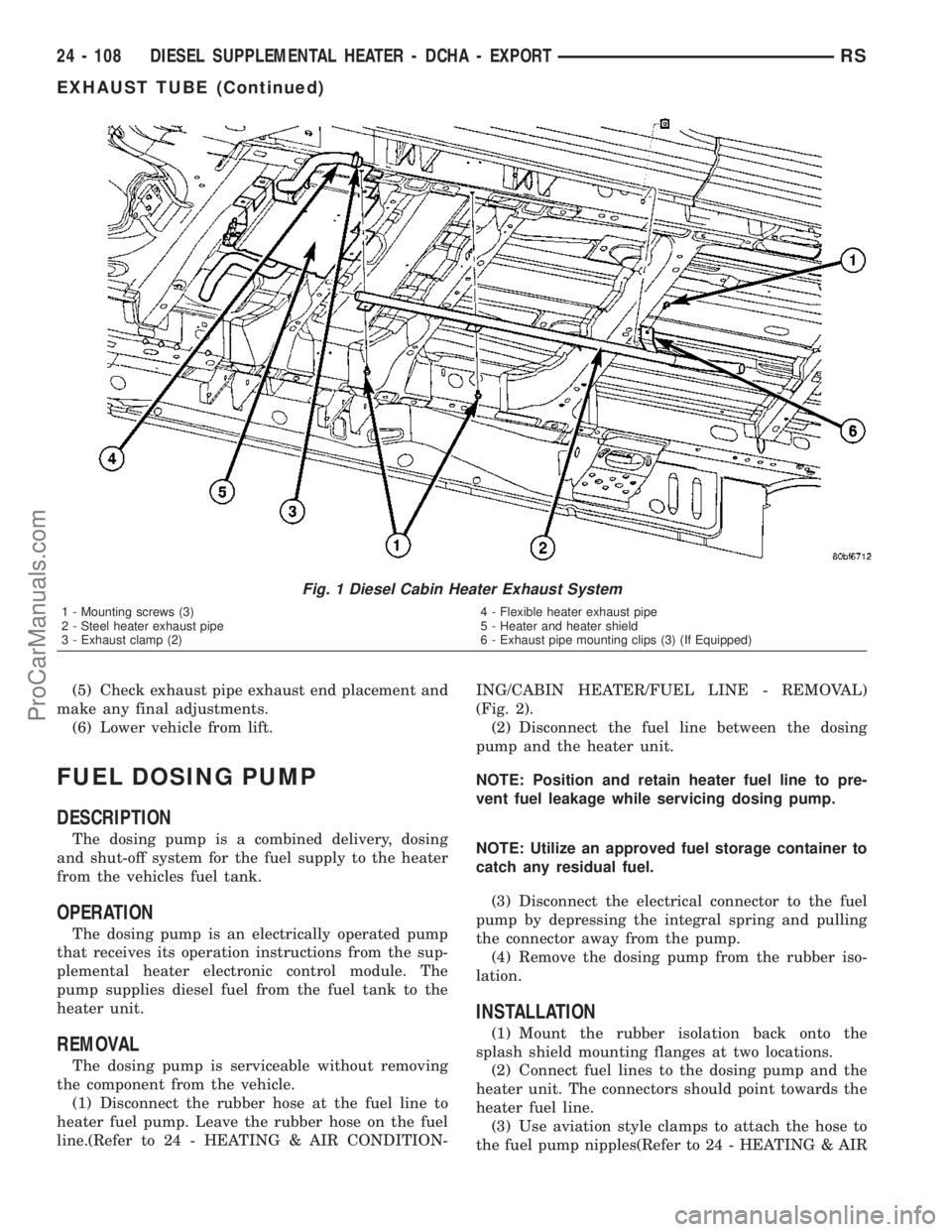
(5) Check exhaust pipe exhaust end placement and
make any final adjustments.
(6) Lower vehicle from lift.
FUEL DOSING PUMP
DESCRIPTION
The dosing pump is a combined delivery, dosing
and shut-off system for the fuel supply to the heater
from the vehicles fuel tank.
OPERATION
The dosing pump is an electrically operated pump
that receives its operation instructions from the sup-
plemental heater electronic control module. The
pump supplies diesel fuel from the fuel tank to the
heater unit.
REMOVAL
The dosing pump is serviceable without removing
the component from the vehicle.
(1) Disconnect the rubber hose at the fuel line to
heater fuel pump. Leave the rubber hose on the fuel
line.(Refer to 24 - HEATING & AIR CONDITION-ING/CABIN HEATER/FUEL LINE - REMOVAL)
(Fig. 2).
(2) Disconnect the fuel line between the dosing
pump and the heater unit.
NOTE: Position and retain heater fuel line to pre-
vent fuel leakage while servicing dosing pump.
NOTE: Utilize an approved fuel storage container to
catch any residual fuel.
(3) Disconnect the electrical connector to the fuel
pump by depressing the integral spring and pulling
the connector away from the pump.
(4) Remove the dosing pump from the rubber iso-
lation.
INSTALLATION
(1) Mount the rubber isolation back onto the
splash shield mounting flanges at two locations.
(2) Connect fuel lines to the dosing pump and the
heater unit. The connectors should point towards the
heater fuel line.
(3) Use aviation style clamps to attach the hose to
the fuel pump nipples(Refer to 24 - HEATING & AIR
Fig. 1 Diesel Cabin Heater Exhaust System
1 - Mounting screws (3)
2 - Steel heater exhaust pipe
3 - Exhaust clamp (2)4 - Flexible heater exhaust pipe
5 - Heater and heater shield
6 - Exhaust pipe mounting clips (3) (If Equipped)
24 - 108 DIESEL SUPPLEMENTAL HEATER - DCHA - EXPORTRS
EXHAUST TUBE (Continued)
ProCarManuals.com
Page 2106 of 2177
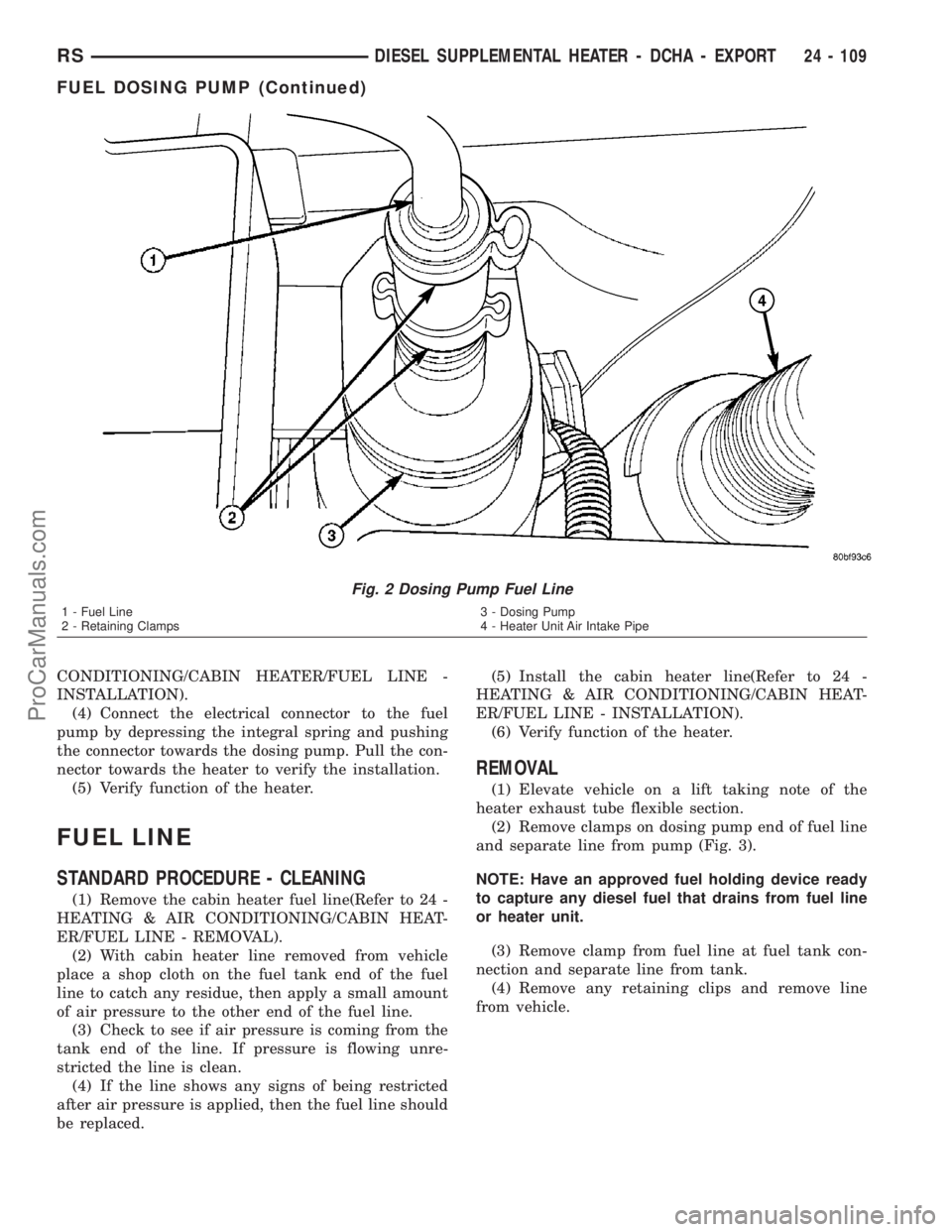
CONDITIONING/CABIN HEATER/FUEL LINE -
INSTALLATION).
(4) Connect the electrical connector to the fuel
pump by depressing the integral spring and pushing
the connector towards the dosing pump. Pull the con-
nector towards the heater to verify the installation.
(5) Verify function of the heater.
FUEL LINE
STANDARD PROCEDURE - CLEANING
(1) Remove the cabin heater fuel line(Refer to 24 -
HEATING & AIR CONDITIONING/CABIN HEAT-
ER/FUEL LINE - REMOVAL).
(2) With cabin heater line removed from vehicle
place a shop cloth on the fuel tank end of the fuel
line to catch any residue, then apply a small amount
of air pressure to the other end of the fuel line.
(3) Check to see if air pressure is coming from the
tank end of the line. If pressure is flowing unre-
stricted the line is clean.
(4) If the line shows any signs of being restricted
after air pressure is applied, then the fuel line should
be replaced.(5) Install the cabin heater line(Refer to 24 -
HEATING & AIR CONDITIONING/CABIN HEAT-
ER/FUEL LINE - INSTALLATION).
(6) Verify function of the heater.
REMOVAL
(1) Elevate vehicle on a lift taking note of the
heater exhaust tube flexible section.
(2) Remove clamps on dosing pump end of fuel line
and separate line from pump (Fig. 3).
NOTE: Have an approved fuel holding device ready
to capture any diesel fuel that drains from fuel line
or heater unit.
(3) Remove clamp from fuel line at fuel tank con-
nection and separate line from tank.
(4) Remove any retaining clips and remove line
from vehicle.
Fig. 2 Dosing Pump Fuel Line
1 - Fuel Line
2 - Retaining Clamps3 - Dosing Pump
4 - Heater Unit Air Intake Pipe
RSDIESEL SUPPLEMENTAL HEATER - DCHA - EXPORT24 - 109
FUEL DOSING PUMP (Continued)
ProCarManuals.com
Page 2121 of 2177
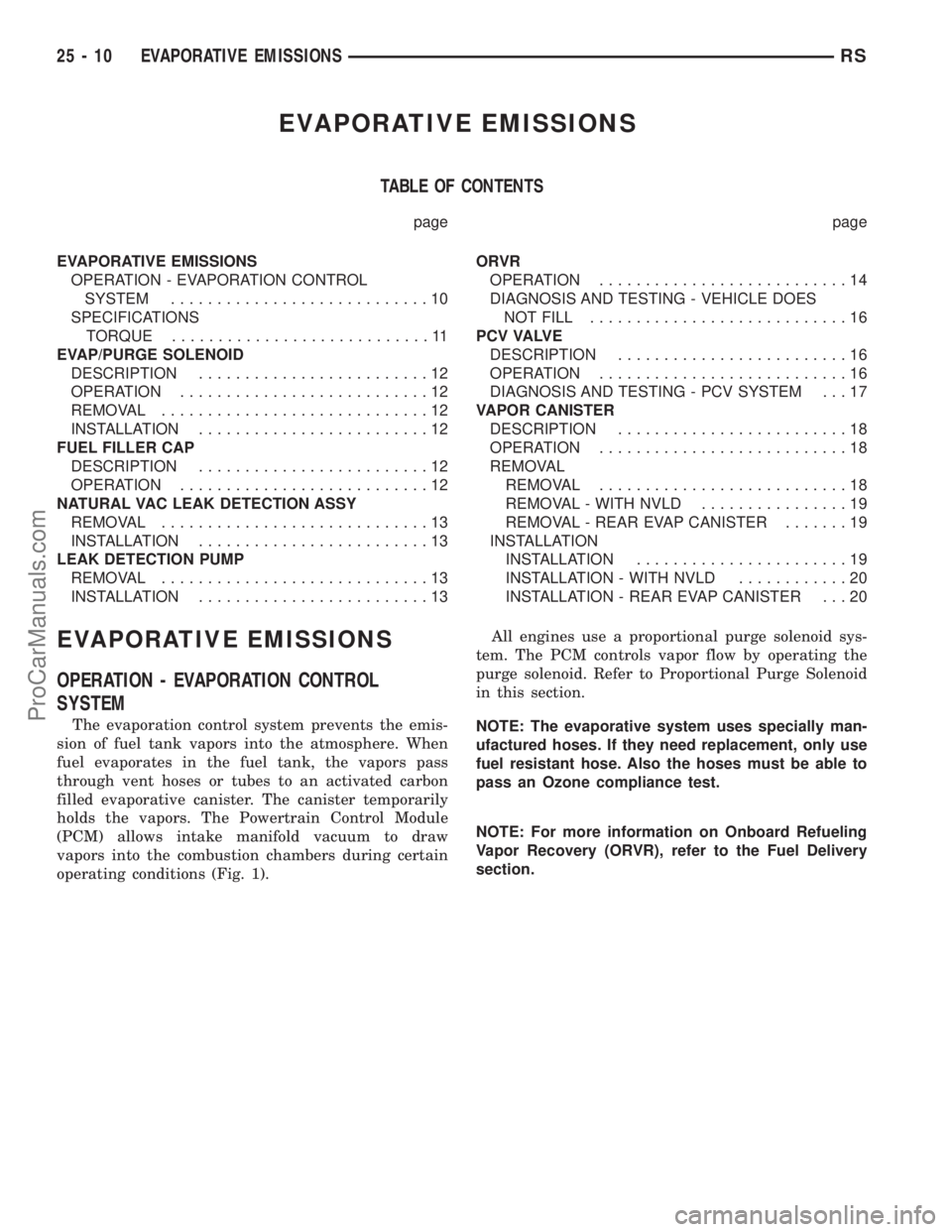
EVAPORATIVE EMISSIONS
TABLE OF CONTENTS
page page
EVAPORATIVE EMISSIONS
OPERATION - EVAPORATION CONTROL
SYSTEM............................10
SPECIFICATIONS
TORQUE............................11
EVAP/PURGE SOLENOID
DESCRIPTION.........................12
OPERATION...........................12
REMOVAL.............................12
INSTALLATION.........................12
FUEL FILLER CAP
DESCRIPTION.........................12
OPERATION...........................12
NATURAL VAC LEAK DETECTION ASSY
REMOVAL.............................13
INSTALLATION.........................13
LEAK DETECTION PUMP
REMOVAL.............................13
INSTALLATION.........................13ORVR
OPERATION...........................14
DIAGNOSIS AND TESTING - VEHICLE DOES
NOT FILL............................16
P C V VA LV E
DESCRIPTION.........................16
OPERATION...........................16
DIAGNOSIS AND TESTING - PCV SYSTEM . . . 17
VAPOR CANISTER
DESCRIPTION.........................18
OPERATION...........................18
REMOVAL
REMOVAL...........................18
REMOVAL - WITH NVLD................19
REMOVAL - REAR EVAP CANISTER.......19
INSTALLATION
INSTALLATION.......................19
INSTALLATION - WITH NVLD............20
INSTALLATION - REAR EVAP CANISTER . . . 20
EVAPORATIVE EMISSIONS
OPERATION - EVAPORATION CONTROL
SYSTEM
The evaporation control system prevents the emis-
sion of fuel tank vapors into the atmosphere. When
fuel evaporates in the fuel tank, the vapors pass
through vent hoses or tubes to an activated carbon
filled evaporative canister. The canister temporarily
holds the vapors. The Powertrain Control Module
(PCM) allows intake manifold vacuum to draw
vapors into the combustion chambers during certain
operating conditions (Fig. 1).All engines use a proportional purge solenoid sys-
tem. The PCM controls vapor flow by operating the
purge solenoid. Refer to Proportional Purge Solenoid
in this section.
NOTE: The evaporative system uses specially man-
ufactured hoses. If they need replacement, only use
fuel resistant hose. Also the hoses must be able to
pass an Ozone compliance test.
NOTE: For more information on Onboard Refueling
Vapor Recovery (ORVR), refer to the Fuel Delivery
section.
25 - 10 EVAPORATIVE EMISSIONSRS
ProCarManuals.com
Page 2123 of 2177
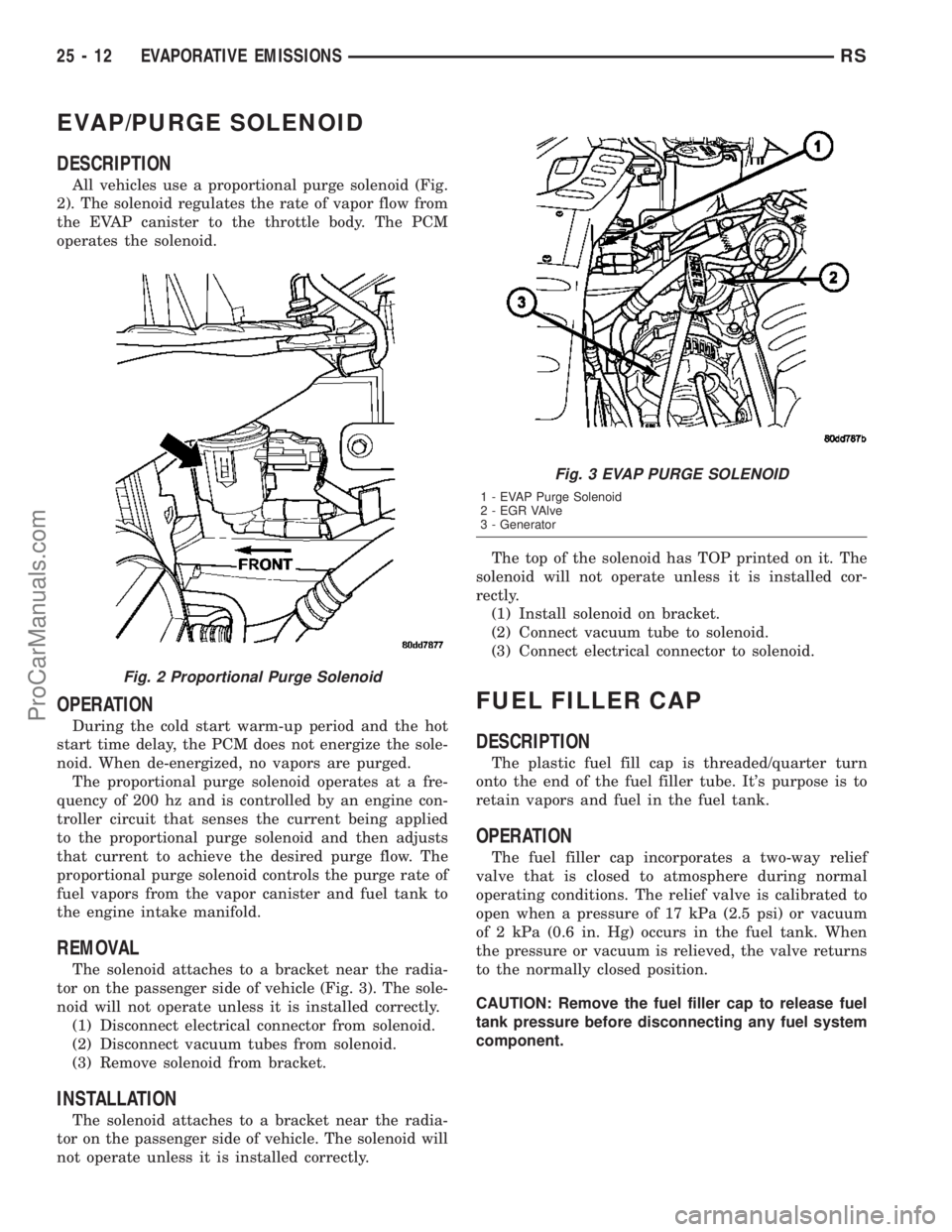
EVAP/PURGE SOLENOID
DESCRIPTION
All vehicles use a proportional purge solenoid (Fig.
2). The solenoid regulates the rate of vapor flow from
the EVAP canister to the throttle body. The PCM
operates the solenoid.
OPERATION
During the cold start warm-up period and the hot
start time delay, the PCM does not energize the sole-
noid. When de-energized, no vapors are purged.
The proportional purge solenoid operates at a fre-
quency of 200 hz and is controlled by an engine con-
troller circuit that senses the current being applied
to the proportional purge solenoid and then adjusts
that current to achieve the desired purge flow. The
proportional purge solenoid controls the purge rate of
fuel vapors from the vapor canister and fuel tank to
the engine intake manifold.
REMOVAL
The solenoid attaches to a bracket near the radia-
tor on the passenger side of vehicle (Fig. 3). The sole-
noid will not operate unless it is installed correctly.
(1) Disconnect electrical connector from solenoid.
(2) Disconnect vacuum tubes from solenoid.
(3) Remove solenoid from bracket.
INSTALLATION
The solenoid attaches to a bracket near the radia-
tor on the passenger side of vehicle. The solenoid will
not operate unless it is installed correctly.The top of the solenoid has TOP printed on it. The
solenoid will not operate unless it is installed cor-
rectly.
(1) Install solenoid on bracket.
(2) Connect vacuum tube to solenoid.
(3) Connect electrical connector to solenoid.
FUEL FILLER CAP
DESCRIPTION
The plastic fuel fill cap is threaded/quarter turn
onto the end of the fuel filler tube. It's purpose is to
retain vapors and fuel in the fuel tank.
OPERATION
The fuel filler cap incorporates a two-way relief
valve that is closed to atmosphere during normal
operating conditions. The relief valve is calibrated to
open when a pressure of 17 kPa (2.5 psi) or vacuum
of 2 kPa (0.6 in. Hg) occurs in the fuel tank. When
the pressure or vacuum is relieved, the valve returns
to the normally closed position.
CAUTION: Remove the fuel filler cap to release fuel
tank pressure before disconnecting any fuel system
component.
Fig. 2 Proportional Purge Solenoid
Fig. 3 EVAP PURGE SOLENOID
1 - EVAP Purge Solenoid
2 - EGR VAlve
3 - Generator
25 - 12 EVAPORATIVE EMISSIONSRS
ProCarManuals.com
Page 2125 of 2177
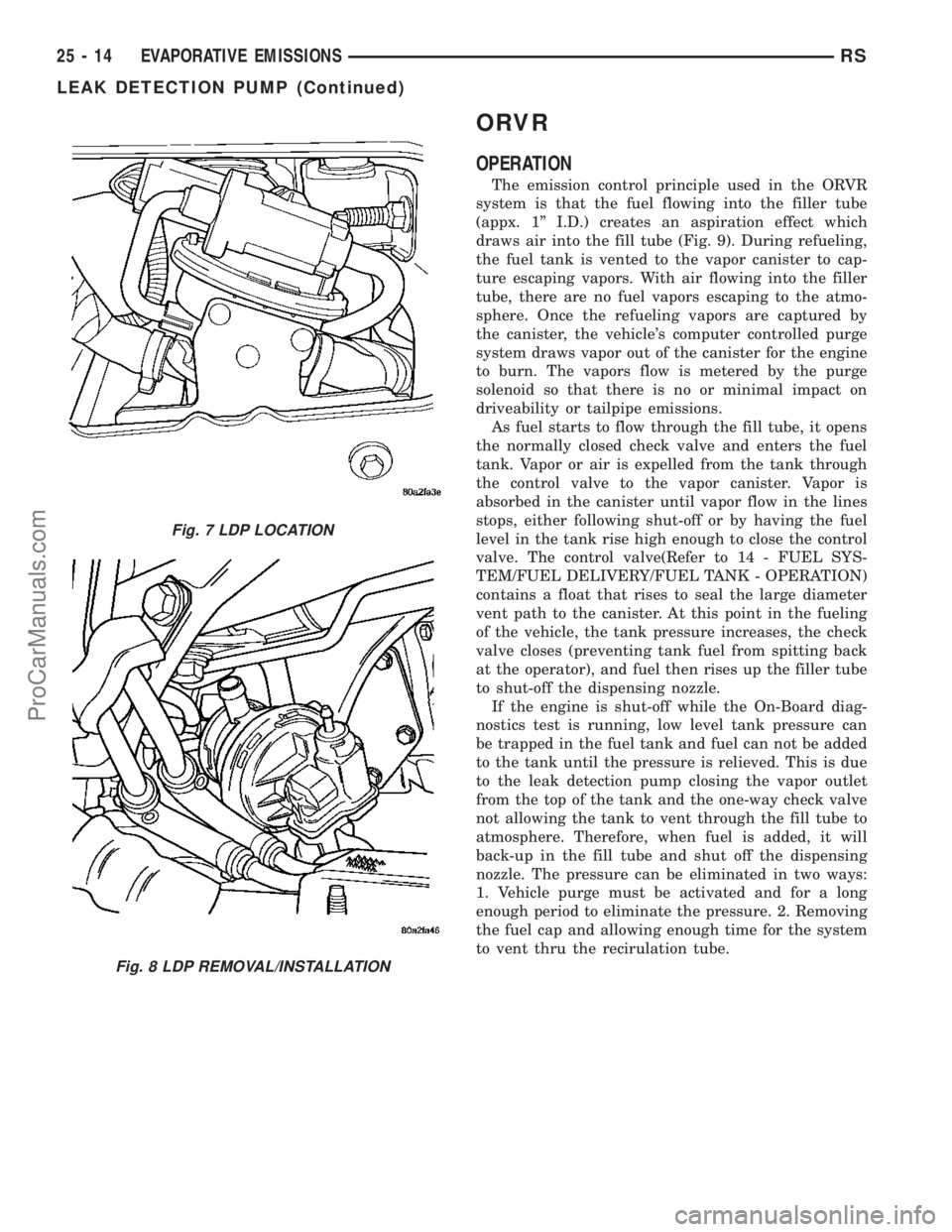
ORVR
OPERATION
The emission control principle used in the ORVR
system is that the fuel flowing into the filler tube
(appx. 1º I.D.) creates an aspiration effect which
draws air into the fill tube (Fig. 9). During refueling,
the fuel tank is vented to the vapor canister to cap-
ture escaping vapors. With air flowing into the filler
tube, there are no fuel vapors escaping to the atmo-
sphere. Once the refueling vapors are captured by
the canister, the vehicle's computer controlled purge
system draws vapor out of the canister for the engine
to burn. The vapors flow is metered by the purge
solenoid so that there is no or minimal impact on
driveability or tailpipe emissions.
As fuel starts to flow through the fill tube, it opens
the normally closed check valve and enters the fuel
tank. Vapor or air is expelled from the tank through
the control valve to the vapor canister. Vapor is
absorbed in the canister until vapor flow in the lines
stops, either following shut-off or by having the fuel
level in the tank rise high enough to close the control
valve. The control valve(Refer to 14 - FUEL SYS-
TEM/FUEL DELIVERY/FUEL TANK - OPERATION)
contains a float that rises to seal the large diameter
vent path to the canister. At this point in the fueling
of the vehicle, the tank pressure increases, the check
valve closes (preventing tank fuel from spitting back
at the operator), and fuel then rises up the filler tube
to shut-off the dispensing nozzle.
If the engine is shut-off while the On-Board diag-
nostics test is running, low level tank pressure can
be trapped in the fuel tank and fuel can not be added
to the tank until the pressure is relieved. This is due
to the leak detection pump closing the vapor outlet
from the top of the tank and the one-way check valve
not allowing the tank to vent through the fill tube to
atmosphere. Therefore, when fuel is added, it will
back-up in the fill tube and shut off the dispensing
nozzle. The pressure can be eliminated in two ways:
1. Vehicle purge must be activated and for a long
enough period to eliminate the pressure. 2. Removing
the fuel cap and allowing enough time for the system
to vent thru the recirulation tube.
Fig. 7 LDP LOCATION
Fig. 8 LDP REMOVAL/INSTALLATION
25 - 14 EVAPORATIVE EMISSIONSRS
LEAK DETECTION PUMP (Continued)
ProCarManuals.com
Page 2129 of 2177
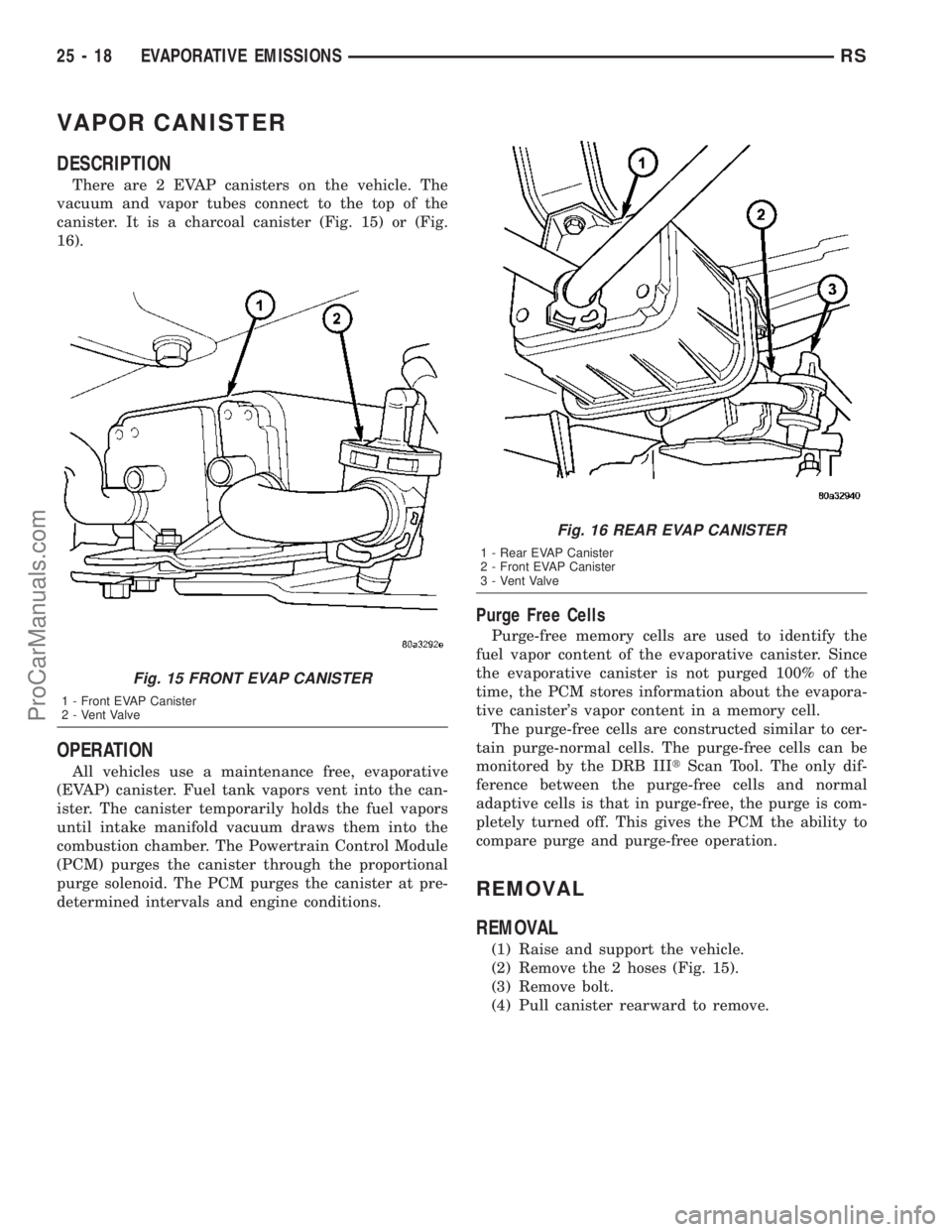
VAPOR CANISTER
DESCRIPTION
There are 2 EVAP canisters on the vehicle. The
vacuum and vapor tubes connect to the top of the
canister. It is a charcoal canister (Fig. 15) or (Fig.
16).
OPERATION
All vehicles use a maintenance free, evaporative
(EVAP) canister. Fuel tank vapors vent into the can-
ister. The canister temporarily holds the fuel vapors
until intake manifold vacuum draws them into the
combustion chamber. The Powertrain Control Module
(PCM) purges the canister through the proportional
purge solenoid. The PCM purges the canister at pre-
determined intervals and engine conditions.
Purge Free Cells
Purge-free memory cells are used to identify the
fuel vapor content of the evaporative canister. Since
the evaporative canister is not purged 100% of the
time, the PCM stores information about the evapora-
tive canister's vapor content in a memory cell.
The purge-free cells are constructed similar to cer-
tain purge-normal cells. The purge-free cells can be
monitored by the DRB IIItScan Tool. The only dif-
ference between the purge-free cells and normal
adaptive cells is that in purge-free, the purge is com-
pletely turned off. This gives the PCM the ability to
compare purge and purge-free operation.
REMOVAL
REMOVAL
(1) Raise and support the vehicle.
(2) Remove the 2 hoses (Fig. 15).
(3) Remove bolt.
(4) Pull canister rearward to remove.
Fig. 15 FRONT EVAP CANISTER
1 - Front EVAP Canister
2 - Vent Valve
Fig. 16 REAR EVAP CANISTER
1 - Rear EVAP Canister
2 - Front EVAP Canister
3 - Vent Valve
25 - 18 EVAPORATIVE EMISSIONSRS
ProCarManuals.com
Page 2149 of 2177
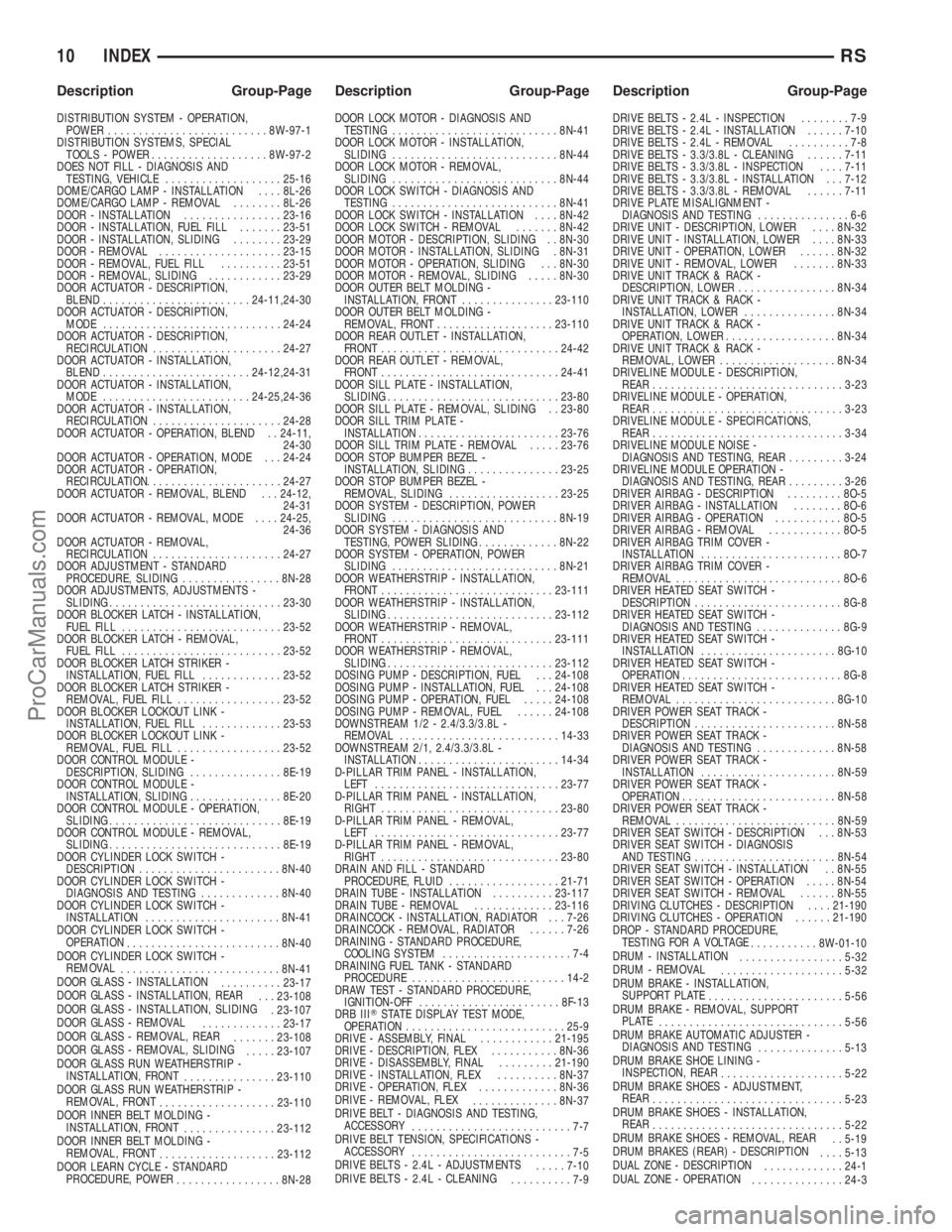
DISTRIBUTION SYSTEM - OPERATION,
POWER..........................8W-97-1
DISTRIBUTION SYSTEMS, SPECIAL
TOOLS - POWER...................8W-97-2
DOES NOT FILL - DIAGNOSIS AND
TESTING, VEHICLE...................25-16
DOME/CARGO LAMP - INSTALLATION....8L-26
DOME/CARGO LAMP - REMOVAL........8L-26
DOOR - INSTALLATION................23-16
DOOR - INSTALLATION, FUEL FILL.......23-51
DOOR - INSTALLATION, SLIDING........23-29
DOOR - REMOVAL....................23-15
DOOR - REMOVAL, FUEL FILL..........23-51
DOOR - REMOVAL, SLIDING............23-29
DOOR ACTUATOR - DESCRIPTION,
BLEND........................24-11,24-30
DOOR ACTUATOR - DESCRIPTION,
MODE.............................24-24
DOOR ACTUATOR - DESCRIPTION,
RECIRCULATION.....................24-27
DOOR ACTUATOR - INSTALLATION,
BLEND........................24-12,24-31
DOOR ACTUATOR - INSTALLATION,
MODE........................24-25,24-36
DOOR ACTUATOR - INSTALLATION,
RECIRCULATION.....................24-28
DOOR ACTUATOR - OPERATION, BLEND . . 24-11,
24-30
DOOR ACTUATOR - OPERATION, MODE . . . 24-24
DOOR ACTUATOR - OPERATION,
RECIRCULATION.......................24-27
DOOR ACTUATOR - REMOVAL, BLEND . . . 24-12,
24-31
DOOR ACTUATOR - REMOVAL, MODE....24-25,
24-36
DOOR ACTUATOR - REMOVAL,
RECIRCULATION.....................24-27
DOOR ADJUSTMENT - STANDARD
PROCEDURE, SLIDING................8N-28
DOOR ADJUSTMENTS, ADJUSTMENTS -
SLIDING............................23-30
DOOR BLOCKER LATCH - INSTALLATION,
FUEL FILL..........................23-52
DOOR BLOCKER LATCH - REMOVAL,
FUEL FILL..........................23-52
DOOR BLOCKER LATCH STRIKER -
INSTALLATION, FUEL FILL.............23-52
DOOR BLOCKER LATCH STRIKER -
REMOVAL, FUEL FILL.................23-52
DOOR BLOCKER LOCKOUT LINK -
INSTALLATION, FUEL FILL.............23-53
DOOR BLOCKER LOCKOUT LINK -
REMOVAL, FUEL FILL.................23-52
DOOR CONTROL MODULE -
DESCRIPTION, SLIDING...............8E-19
DOOR CONTROL MODULE -
INSTALLATION, SLIDING...............8E-20
DOOR CONTROL MODULE - OPERATION,
SLIDING............................8E-19
DOOR CONTROL MODULE - REMOVAL,
SLIDING............................8E-19
DOOR CYLINDER LOCK SWITCH -
DESCRIPTION.......................8N-40
DOOR CYLINDER LOCK SWITCH -
DIAGNOSIS AND TESTING.............8N-40
DOOR CYLINDER LOCK SWITCH -
INSTALLATION......................8N-41
DOOR CYLINDER LOCK SWITCH -
OPERATION
.........................8N-40
DOOR CYLINDER LOCK SWITCH -
REMOVAL
..........................8N-41
DOOR GLASS - INSTALLATION
..........23-17
DOOR GLASS - INSTALLATION, REAR
. . . 23-108
DOOR GLASS - INSTALLATION, SLIDING
. 23-107
DOOR GLASS - REMOVAL
.............23-17
DOOR GLASS - REMOVAL, REAR
.......23-108
DOOR GLASS - REMOVAL, SLIDING
.....23-107
DOOR GLASS RUN WEATHERSTRIP -
INSTALLATION, FRONT
...............23-110
DOOR GLASS RUN WEATHERSTRIP -
REMOVAL, FRONT
...................23-110
DOOR INNER BELT MOLDING -
INSTALLATION, FRONT
...............23-112
DOOR INNER BELT MOLDING -
REMOVAL, FRONT
...................23-112
DOOR LEARN CYCLE - STANDARD
PROCEDURE, POWER
.................8N-28DOOR LOCK MOTOR - DIAGNOSIS AND
TESTING...........................8N-41
DOOR LOCK MOTOR - INSTALLATION,
SLIDING...........................8N-44
DOOR LOCK MOTOR - REMOVAL,
SLIDING...........................8N-44
DOOR LOCK SWITCH - DIAGNOSIS AND
TESTING...........................8N-41
DOOR LOCK SWITCH - INSTALLATION....8N-42
DOOR LOCK SWITCH - REMOVAL.......8N-42
DOOR MOTOR - DESCRIPTION, SLIDING . . 8N-30
DOOR MOTOR - INSTALLATION, SLIDING . 8N-31
DOOR MOTOR - OPERATION, SLIDING . . . 8N-30
DOOR MOTOR - REMOVAL, SLIDING.....8N-30
DOOR OUTER BELT MOLDING -
INSTALLATION, FRONT...............23-110
DOOR OUTER BELT MOLDING -
REMOVAL, FRONT...................23-110
DOOR REAR OUTLET - INSTALLATION,
FRONT.............................24-42
DOOR REAR OUTLET - REMOVAL,
FRONT.............................24-41
DOOR SILL PLATE - INSTALLATION,
SLIDING............................23-80
DOOR SILL PLATE - REMOVAL, SLIDING . . 23-80
DOOR SILL TRIM PLATE -
INSTALLATION.......................23-76
DOOR SILL TRIM PLATE - REMOVAL.....23-76
DOOR STOP BUMPER BEZEL -
INSTALLATION, SLIDING...............23-25
DOOR STOP BUMPER BEZEL -
REMOVAL, SLIDING..................23-25
DOOR SYSTEM - DESCRIPTION, POWER
SLIDING...........................8N-19
DOOR SYSTEM - DIAGNOSIS AND
TESTING, POWER SLIDING.............8N-22
DOOR SYSTEM - OPERATION, POWER
SLIDING...........................8N-21
DOOR WEATHERSTRIP - INSTALLATION,
FRONT............................23-111
DOOR WEATHERSTRIP - INSTALLATION,
SLIDING...........................23-112
DOOR WEATHERSTRIP - REMOVAL,
FRONT............................23-111
DOOR WEATHERSTRIP - REMOVAL,
SLIDING...........................23-112
DOSING PUMP - DESCRIPTION, FUEL . . . 24-108
DOSING PUMP - INSTALLATION, FUEL . . . 24-108
DOSING PUMP - OPERATION, FUEL.....24-108
DOSING PUMP - REMOVAL, FUEL......24-108
DOWNSTREAM 1/2 - 2.4/3.3/3.8L -
REMOVAL..........................14-33
DOWNSTREAM 2/1, 2.4/3.3/3.8L -
INSTALLATION.......................14-34
D-PILLAR TRIM PANEL - INSTALLATION,
LEFT..............................23-77
D-PILLAR TRIM PANEL - INSTALLATION,
RIGHT.............................23-80
D-PILLAR TRIM PANEL - REMOVAL,
LEFT..............................23-77
D-PILLAR TRIM PANEL - REMOVAL,
RIGHT.............................23-80
DRAIN AND FILL - STANDARD
PROCEDURE, FLUID..................21-71
DRAIN TUBE - INSTALLATION..........23-117
DRAIN TUBE - REMOVAL.............23-116
DRAINCOCK - INSTALLATION, RADIATOR . . . 7-26
DRAINCOCK - REMOVAL, RADIATOR......7-26
DRAINING - STANDARD PROCEDURE,
COOLING SYSTEM.....................7-4
DRAINING FUEL TANK - STANDARD
PROCEDURE.........................14-2
DRAW TEST - STANDARD PROCEDURE,
IGNITION-OFF.......................8F-13
DRB IIITSTATE DISPLAY TEST MODE,
OPERATION..........................25-9
DRIVE - ASSEMBLY, FINAL............21-195
DRIVE - DESCRIPTION, FLEX...........8N-36
DRIVE - DISASSEMBLY, FINAL.........21-190
DRIVE - INSTALLATION, FLEX..........8N-37
DRIVE - OPERATION, FLEX.............8N-36
DRIVE - REMOVAL, FLEX
..............8N-37
DRIVE BELT - DIAGNOSIS AND TESTING,
ACCESSORY
..........................7-7
DRIVE BELT TENSION, SPECIFICATIONS -
ACCESSORY
..........................7-5
DRIVE BELTS - 2.4L - ADJUSTMENTS
.....7-10
DRIVE BELTS - 2.4L - CLEANING
..........7-9DRIVE BELTS - 2.4L - INSPECTION........7-9
DRIVE BELTS - 2.4L - INSTALLATION......7-10
DRIVE BELTS - 2.4L - REMOVAL..........7-8
DRIVE BELTS - 3.3/3.8L - CLEANING......7-11
DRIVE BELTS - 3.3/3.8L - INSPECTION....7-11
DRIVE BELTS - 3.3/3.8L - INSTALLATION . . . 7-12
DRIVE BELTS - 3.3/3.8L - REMOVAL......7-11
DRIVE PLATE MISALIGNMENT -
DIAGNOSIS AND TESTING...............6-6
DRIVE UNIT - DESCRIPTION, LOWER....8N-32
DRIVE UNIT - INSTALLATION, LOWER....8N-33
DRIVE UNIT - OPERATION, LOWER......8N-32
DRIVE UNIT - REMOVAL, LOWER.......8N-33
DRIVE UNIT TRACK & RACK -
DESCRIPTION, LOWER................8N-34
DRIVE UNIT TRACK & RACK -
INSTALLATION, LOWER...............8N-34
DRIVE UNIT TRACK & RACK -
OPERATION, LOWER..................8N-34
DRIVE UNIT TRACK & RACK -
REMOVAL, LOWER...................8N-34
DRIVELINE MODULE - DESCRIPTION,
REAR...............................3-23
DRIVELINE MODULE - OPERATION,
REAR...............................3-23
DRIVELINE MODULE - SPECIFICATIONS,
REAR...............................3-34
DRIVELINE MODULE NOISE -
DIAGNOSIS AND TESTING, REAR.........3-24
DRIVELINE MODULE OPERATION -
DIAGNOSIS AND TESTING, REAR.........3-26
DRIVER AIRBAG - DESCRIPTION.........8O-5
DRIVER AIRBAG - INSTALLATION........8O-6
DRIVER AIRBAG - OPERATION...........8O-5
DRIVER AIRBAG - REMOVAL............8O-5
DRIVER AIRBAG TRIM COVER -
INSTALLATION.......................8O-7
DRIVER AIRBAG TRIM COVER -
REMOVAL...........................8O-6
DRIVER HEATED SEAT SWITCH -
DESCRIPTION........................8G-8
DRIVER HEATED SEAT SWITCH -
DIAGNOSIS AND TESTING..............8G-9
DRIVER HEATED SEAT SWITCH -
INSTALLATION......................8G-10
DRIVER HEATED SEAT SWITCH -
OPERATION..........................8G-8
DRIVER HEATED SEAT SWITCH -
REMOVAL..........................8G-10
DRIVER POWER SEAT TRACK -
DESCRIPTION.......................8N-58
DRIVER POWER SEAT TRACK -
DIAGNOSIS AND TESTING.............8N-58
DRIVER POWER SEAT TRACK -
INSTALLATION......................8N-59
DRIVER POWER SEAT TRACK -
OPERATION.........................8N-58
DRIVER POWER SEAT TRACK -
REMOVAL..........................8N-59
DRIVER SEAT SWITCH - DESCRIPTION . . . 8N-53
DRIVER SEAT SWITCH - DIAGNOSIS
AND TESTING.......................8N-54
DRIVER SEAT SWITCH - INSTALLATION . . 8N-55
DRIVER SEAT SWITCH - OPERATION.....8N-54
DRIVER SEAT SWITCH - REMOVAL......8N-55
DRIVING CLUTCHES - DESCRIPTION....21-190
DRIVING CLUTCHES - OPERATION......21-190
DROP - STANDARD PROCEDURE,
TESTING FOR A VOLTAGE
...........8W-01-10
DRUM - INSTALLATION
.................5-32
DRUM - REMOVAL
....................5-32
DRUM BRAKE - INSTALLATION,
SUPPORT PLATE
......................5-56
DRUM BRAKE - REMOVAL, SUPPORT
PLATE
..............................5-56
DRUM BRAKE AUTOMATIC ADJUSTER -
DIAGNOSIS AND TESTING
..............5-13
DRUM BRAKE SHOE LINING -
INSPECTION, REAR
....................5-22
DRUM BRAKE SHOES - ADJUSTMENT,
REAR
...............................5-23
DRUM BRAKE SHOES - INSTALLATION,
REAR
...............................5-22
DRUM BRAKE SHOES - REMOVAL, REAR
. . 5-19
DRUM BRAKES (REAR) - DESCRIPTION
....5-13
DUAL ZONE - DESCRIPTION
.............24-1
DUAL ZONE - OPERATION
...............24-3
10 INDEXRS
Description Group-Page Description Group-Page Description Group-Page
ProCarManuals.com